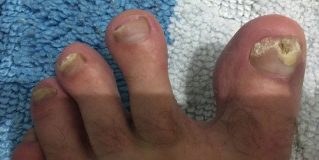Nail fungus is ugly and painful. The main thing in the treatment is to use folk remedies as not to pick up an infection.
How to understand that it is a fungus
Suspected onychomycosis by symptoms:
- Change the color of the nail. It all starts with small spots, the nail lighter or yellow. Over time can darken and even green.
- Change your form. The nail grows, not there, on the plate, the waves appear.
- Discomfort, especially if you press on the nail.
- The fragility. The nail begins to flake, become brittle. It is noticeable that changed the structure of the plate.
But it is best to consult with diagnostic lab tests that will refer dermatologist: the nail that around, you need to scrape and examine under the microscope.

Where does fungus
All around us are living microorganisms, including various fungi. Usually they do not interfere with us. But if the fungus gets into favorable conditions, it begins to multiply rapidly.
The perfect environment for fungus — the place where it is warm and humid. For example, tight shoes in the gym locker room or in the shower, in the bath or in the pool.
Why show nails the doctor
He found that it's definitely a fungus. Without research it is not always clear, especially if the infection only began to spread.
Perhaps the nails have changed due to injury, bacteria or psoriasis — then antifungal medicines purchased on their own, no help.
How to treat nail fungus
Now pharmacies quite fungicides that kill fungus in the nails even, they are sold under different names. To treat the skin around the nail is easier to use medication in the form of ointments for the treatment of the plate — drops or a special antifungal nail Polish.
The only difficulty in the treatment of nail fungus: it is necessary to use the medication a few months to half a year. So the main thing is patience and consistency.
If the fungus is strongly deformed nail, you should visit a specialist who deals with the health of the feet and treating the infected nail so that it does not interfere with live. And it would be a change or at least to disinfect inside of the shoes that contact with the affected nails.
In rare occasions it is necessary to remove the nail.
It is necessary to treat fungus folk remedies
All folk remedies — this is a dubious alternative to pharmaceutical antibiotics. Iodine, vinegar, herbal infusions and juices, salt — it's all weak antiseptics that can kill fungi on the surface of the nail, but can't completely lime infection.
The most effective of these tools is also extremely dangerous, because burn the skin and only worsen the situation.
Much easier to buy drugs and not to suffer, inventing the next tray with the homicide squad. The only advantage of warm baths for the feet — nail is a bit limp, so there's a chance that antifungal ointments and drops will work better.
What is the danger of fungus, if left untreated
Fungal infections are treated for a long time, so many people forget to use products or do not buy a new pack when the old one ran out, and the treatment is not completed.

If the fungus is not stopped, it spreads, the entire nail becomes thick and hard, begin to turn yellow and crumble. The skin around the nail and under it can hurt, it increases the risk of injuries, ingrown nail and its stratification.
If the infection moves to the skin between the toes and on the foot, you will appear and cracks, which also hurts.
How not to catch a nail fungus
Fungi often attack people whose immune system cannot cope with the infection: for example, their bodies weakened by chronic diseases. Therefore, people suffering from diabetes or psoriasis must be especially attentive to the health of nails.
- Follow the hygiene. Clean and dry hands and feet, the fungus are not attracted to. So wash your limbs and shoes, change socks every day (and if necessary, even several times a day) don't forget to clean and trim your nails.
- Carefully choose the fabric that will be in contact with the nails. Socks made of cotton, gloves made of natural materials.
- Wear Slippers and flip-flops, especially in the locker rooms and showers.
- Wear second pair of shoes. Do not sit all day in the same shoes that walk on the street, especially if we are talking about winter boots and shoes: do not let the feet to sweat.
- Don't share towels. It is personal hygiene items, like toothbrush.
- Do not do manicure and pedicure at home or salon where not well handle the tools — so not only can catch the fungus, but something worse.





























